Mastering Pool Chemistry: Chlorine Stability & Cyanuric Acid Guide
December 01th, 2024
December 01th, 2024
The shimmering allure of a well-maintained pool can transform any backyard into a personal oasis. Yet, beneath the sparkling surface lies a delicate chemistry that keeps the water inviting and clean. One essential component of this mix is cyanuric acid (CYA), often dubbed the “pool stabilizer.” It plays a crucial role in shielding chlorine from the sun's relentless UV rays, prolonging its effectiveness. Without sufficient CYA, your pool water may soon become a breeding ground for bacteria, as chlorine dissipates faster than you can say “cannonball.”
Several months ago, a neighbor shared an anecdote about a frustrating summer spent battling unclear pool water, only to discover that low CYA levels were sabotaging their efforts. This common issue underscores the importance of regularly monitoring and maintaining appropriate CYA concentrations. Ideally, these levels should sit between 30 and 50 parts per million (ppm) for optimal protection, depending on whether your pool is exposed or covered.
Whether you're a seasoned pool caretaker or new to the world of water management, understanding how to adjust CYA levels is essential. It’s not just about dumping chemicals and hoping for the best; it’s about creating a balanced environment where pool maintenance becomes less of a chore and more of a science. Dive into this guide to learn effective strategies for elevating your pool’s CYA, ensuring it remains a pristine escape throughout the swim season.
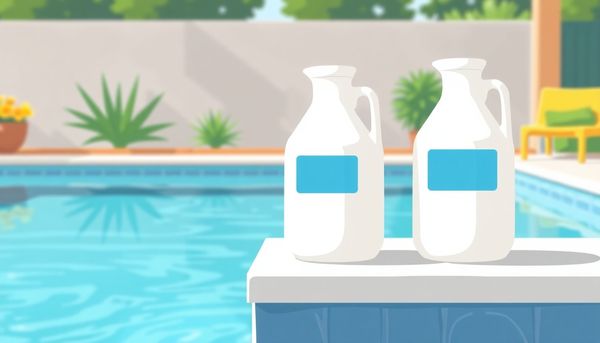
Raising cyanuric acid levels in your pool is a bit like safeguarding your investment from the elements. Anyone who’s spent a sunny afternoon skimming leaves and debris knows the satisfaction of clear water glistening back at you. Yet, without the right balance of cyanuric acid, this clarity can be fleeting, especially under the relentless sun.
To address low cyanuric acid, one effective method is to incorporate a pool stabilizer directly into the water. This granular or liquid additive is pure cyanuric acid. For a 10,000-gallon pool, about 13 ounces of stabilizer can increase CYA levels by 10 ppm. However, precision matters here; too much can be as troublesome as too little. Always dissolve the stabilizer in a bucket of pool water before introducing it to your skimmer, a trick I picked up after splashing my way into an unintentional mess one summer.
Alternatively, switching to stabilized chlorine, such as dichlor or trichlor, can be a convenient dual-purpose choice. These options sanitize your pool while gradually boosting CYA levels. In my experience, keeping a stash of these on hand has saved me numerous trips to the pool supply store. Remember, though, it’s easier to add than to remove excess CYA, so proceed with careful measurement and regular testing. Your pool—and your peace of mind—will undoubtedly benefit from this balanced approach.
While diving into the chemistry of pool maintenance might seem daunting, using stabilized chlorine is a straightforward and effective strategy to manage your cyanuric acid (CYA) levels. Imagine you’ve just discovered your pool’s CYA levels have taken a nosedive. This scenario calls for a solution that not only boosts those levels but also ensures your pool remains a haven for relaxation, not bacteria. Enter stabilized chlorine — a two-in-one hero for pool care.
Stabilized chlorine, found in products such as sodium dichlor and trichlor, comes equipped with its own built-in sunblock, cyanuric acid. This means when you add it to your pool, you're not just adding chlorine; you're also fortifying it against the sun's relentless UV rays, which can otherwise reduce chlorine to a mere shadow of its effective self. So, as you scatter those granular forms or drop in a puck, you’re not only sanitizing your pool but also maintaining that all-important CYA balance.
Consider this: on a particularly sunny afternoon, a friend who uses unstabilized chlorine mentions having to constantly adjust their chlorine levels. Meanwhile, your pool continues to glisten without the need for excessive intervention. That’s the advantage of stabilized chlorine. It’s like having a sunscreen for your pool, saving both time and resources. By incorporating stabilized chlorine into your regular pool maintenance, you not only resolve low CYA issues but also create a robust defense against the elements.
Understanding the significance of cyanuric acid, often termed pool conditioner, is key to maintaining a healthy swimming pool environment. When the blazing sun is overhead, it mercilessly depletes chlorine, the primary sanitizer, leaving your pool vulnerable to impurities. If your CYA levels are too low, sunlight breaks down chlorine rapidly, causing an unsanitary dip in your chlorination efforts. Imagine spending precious time and resources chlorinating your pool, only to have it vanish under UV assault. This is where adding pool conditioner becomes a game changer.
It's crucial first to know your current CYA levels. Use a reliable test kit to measure your pool water’s chemistry, aiming for a CYA level between 30 and 50 ppm, or slightly higher if you own a saltwater pool. Equipped with this knowledge, you can then add a pool stabilizer, which is essentially pure cyanuric acid. Carefully dissolve the stabilizer in a bucket of pool water, ensuring thorough mixing, and introduce it into your pool via the skimmer.
Remember, patience is key. Allow the stabilizer to circulate completely by running the pump for several hours. Retest your water to confirm the levels have stabilized. A word of caution: overdoing it with CYA can lead to complications that require draining some pool water to correct. By managing your CYA levels, you preserve the chlorine's effectiveness, ensuring your pool remains a sparkling oasis.
Testing and adjusting your pool's cyanuric acid (CYA) levels can feel a bit like fine-tuning a musical instrument. Each adjustment brings you closer to harmony, ensuring your chlorine is well-protected from the sun's relentless rays. First, grab a reliable test kit or testing strips to check your current CYA levels. This simple step sets the stage for everything else, giving you a clear snapshot of what your pool needs.
Once you've got your reading, it's time to balance the water's pH and total alkalinity. Think of this as setting the foundation; without it, any chemical additions might not perform as expected. With your base levels steady, you’re ready to introduce either stabilized chlorine or a pool stabilizer to nudge the CYA levels upwards. A measured approach is key here—overdoing it can lead to more headaches than solutions.
After your initial adjustments, patience becomes your greatest ally. Allow the chemicals to circulate, thanks to your pool's filtration system, and then retest. This step is crucial, helping you confirm that the levels have reached that sweet spot between 30 and 50 parts per million (PPM). Remember, adding CYA is much like seasoning food; it’s easier to add more later than to remove excess. By keeping an eye on the numbers and making incremental changes, you'll maintain a pool that's both safe and sparkling, ready for anyone to dive into.
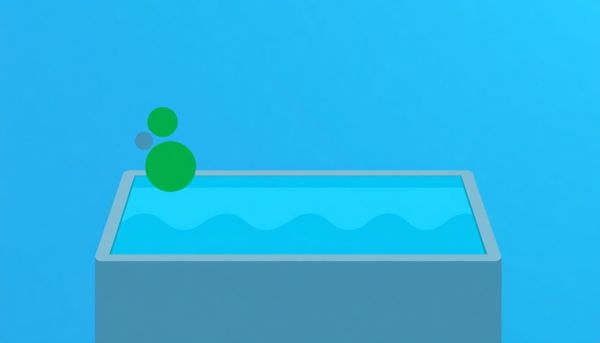
Keeping a pristine outdoor pool can feel like a constant battle against the elements, particularly when it comes to maintaining chlorine levels. The sun, relentless in its brilliance, is one adversary you simply cannot ignore. Without the protective embrace of cyanuric acid (CYA), your chlorine is at the mercy of ultraviolet rays, which can sap its effectiveness in mere hours. This is why stabilizers play such an essential role in pool maintenance.
Imagine spending a sunny afternoon with your family, only to realize the pool water has turned murky and uninviting. That’s a scenario any pool owner wants to avoid. You might wonder, then, how to prevent chlorine from evaporating faster than you can add it. This is where CYA, your pool's unsung guardian, steps in. By forming a protective bond with chlorine, it acts as a shield against UV rays, ensuring your sanitizer remains in the fight longer.
Personal experience taught me the importance of CYA when I moved to a sun-drenched locale. Initially, I underestimated its significance until I experienced a chlorine consumption rate that was through the roof. A quick fix? Not exactly. Careful CYA level adjustments were needed, along with consistent monitoring, to achieve that perfect balance. By adding pool stabilizer or opting for stabilized chlorine, you not only conserve chlorine but also uphold your pool’s health and clarity. So, investing in CYA isn't just a choice—it's a crucial strategy in your pool care arsenal.
Maintaining optimal cyanuric acid (CYA) levels in your pool is akin to ensuring your favorite sunglasses are always within reach on a bright day. Just as sunglasses protect your eyes from the harsh rays of the sun, CYA safeguards your pool's chlorine from swift degradation. Without the right amount of CYA, outdoor pool owners will find themselves in a constant battle against the sun, which relentlessly breaks down chlorine, leaving pool water vulnerable to bacteria and algae outbreaks.
Consider this: You're armed with a test kit and find your CYA levels dipping below the ideal range of 30 to 50 parts per million. It's time to act. Begin by adding a pool stabilizer or conditioner with pure cyanuric acid. For regular maintenance, you might find using stabilized chlorine products—such as trichlor or dichlor—particularly convenient, as they come with built-in CYA. These not only sanitize your pool but also maintain CYA levels, offering a two-for-one solution that many pool owners appreciate.
Remember, balance is key. Before adding CYA, test your pool's pH and alkalinity, adjusting as necessary to ensure effectiveness. Slowly introduce CYA to avoid over-correlating, as lowering excess is a more tedious process compared to raising it. If you ever encounter a situation where levels climb too high, partial water replacement can help reset the balance. With these strategies, you'll uphold a pristine swimming environment, letting you and your pool shine under the sun.
Imagine looking down at your pool and seeing crystal-clear water inviting you for a swim, knowing every drop is perfectly balanced for safety and cleanliness. Achieving this often hinges on using stabilized chlorine. Though it might sound like a small detail, stabilized chlorine, such as sodium dichlor or trichlor, can transform how your pool holds up against the sun’s relentless UV rays. By integrating cyanuric acid directly into its formula, stabilized chlorine acts like a shield, ensuring that your precious chlorine doesn't vanish in the bright summer sun.
Unstabilized options, like liquid bleach or calcium hypochlorite, may seem tempting, but they leave your chlorine exposed, leading to frequent replenishment and, more importantly, potential exposure to unsanitary water conditions. I remember when a friend of mine switched to stabilized chlorine after a particularly hot summer left her pool perpetually cloudy. Within weeks, not only did she notice clearer water, but her maintenance routine became significantly less demanding.
Moreover, incorporating stabilized chlorine is not just about convenience; it's a strategic choice for maintaining a healthy pool environment. By preventing rapid chlorine loss, it keeps the water free from contaminants, reducing the risk of algae blooms and bacterial growth. Always remember, when you’re looking to boost those CYA levels, stabilized chlorine isn’t just an option—it’s a safeguard for your pool and peace of mind.
Sunlight has a knack for sneaking away with your precious pool chlorine, leaving you with unsanitary water and a headache. Enter cyanuric acid (CYA), the unsung hero of pool maintenance. It acts like a sunscreen for your chlorine, reducing its rapid degradation under the relentless sun. But, when CYA levels fall below the ideal 30 to 50 parts per million, this protective shield weakens, and your chlorine can vanish faster than you can say "cannonball".
Ever wondered why your pool’s CYA might be teetering on the low side? Water dilution from rain, splash-out, or even intentional draining can dilute your CYA levels. Similarly, relying on unstabilized chlorine like liquid bleach doesn’t replenish CYA, leaving your pool exposed to UV damage. To counteract this, many pool owners opt for stabilized chlorine, such as dichlor or trichlor, that already contains CYA, effectively hitting two birds with one stone.
If you’ve been caught off guard by low CYA, consider adding a pool stabilizer. Start small and slowly increase the dosage to avoid overcorrection. Overdoing CYA can be tricky since lowering it involves partially draining the pool—an exercise in patience and water conservation. Remember, each pool has its unique balancing act, so test frequently and adjust accordingly. With a bit of attention, you can keep your chlorine working efficiently and your pool sparkling clean all summer long.
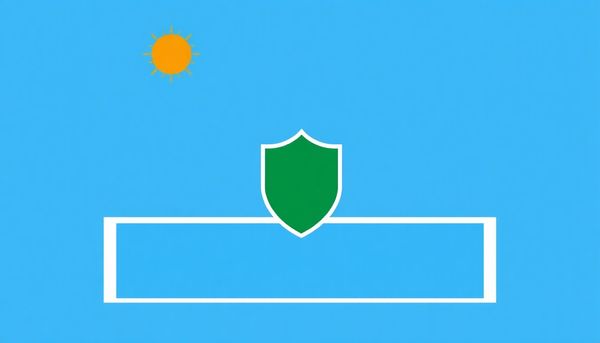
Chlorine and cyanuric acid form an essential duo for outdoor pool owners. When you realize your cyanuric acid levels are low, stabilized chlorine can quickly become your best ally. Stabilized chlorine, in its forms like sodium dichlor and trichlor, not only sanitizes but also extends the life of your chlorine by including CYA in its composition.
Think back to those summer days when relentless sun rays seemed to drink up your pool's chlorine faster than you could add it. That’s where stabilized chlorine shines. By integrating cyanuric acid into your pool routine, you effectively shield your chlorine from the sun’s UV rays, which would otherwise break it down. A personal tip from my own pool escapades: once I switched to trichlor tablets, I noticed I was adding chlorine far less frequently, and my water remained consistently clear.
Moreover, the convenience factor is hard to ignore. With stabilized chlorine, you tackle multiple issues with a single product, simplifying your pool maintenance routine. A word of caution, though: over-reliance can tip the balance, leading to excess CYA, which complicates the situation. Remember to periodically test your pool’s CYA levels to ensure they remain within the recommended 30 to 50 parts per million range. Adjusting your stabilizer intake based on these readings will help maintain the ideal chemical harmony in your pool, ensuring that every swim is as refreshing and safe as the last.
Determining the perfect balance of cyanuric acid (CYA) in your pool isn't a one-and-done task; it demands regular testing and subtle adjustments. You might recall a time when a neglected pool turned into a green, murky mess, making it clear that diligent maintenance is essential. To start, grab a reliable liquid test kit or test strips to measure the current CYA levels. Aim for 30 to 50 parts per million (PPM) for standard pools, and slightly higher for saltwater varieties—between 60 and 80 PPM—as their chlorine production method makes them more susceptible to UV degradation.
Once you've got your baseline figures, consider the options for raising those levels. Stabilized chlorine, such as sodium dichlor or trichlor, conveniently combines both chlorine and CYA, offering a simple dual-action approach. If your pool's chlorine isn't stabilized, you might need to add pure CYA directly. Typically, about 13 ounces of stabilizer will elevate a 10,000-gallon pool’s CYA by 10 PPM, but remember, moderation is key. Overdoing it can lead to challenges in reducing levels later.
After adding the stabilizer, the waiting game begins. Allow your pool pump to circulate the water for several hours, ensuring even distribution. Then, test again. If the levels are still low, repeat the process with a cautious hand. A friend once made the mistake of rushing this step, only to end up draining excess water to bring things back in line—a costly and time-consuming error. By taking things slowly, you keep your pool chemistry stable and inviting, ready for those sunny afternoons with family and friends.
Navigating the chlorine maze can feel like a daunting task, especially when faced with the challenge of low cyanuric acid (CYA) levels. The right choice of chlorine becomes crucial to sustain a clean and safe swimming environment. With a plethora of options available, picking the suitable type of chlorine is key to maintaining balance in your pool chemistry.
Stabilized chlorine products, such as sodium dichlor and trichlor, come infused with cyanuric acid, which acts like sunscreen for your pool’s chlorine. This built-in protection prevents the chlorine from dissipating rapidly under the sun’s UV rays. When I first switched to trichlor tablets for my backyard pool, I noticed a significant difference in how long my chlorine levels stayed consistent. It was a game-changer, allowing me to spend less time fussing over chemical adjustments and more time enjoying a dip in the pool.
On the flip side, unstabilized chlorine options, including liquid bleach and calcium hypochlorite, don’t contain CYA. While they can serve as effective sanitizers, they require frequent supplementation with cyanuric acid to prevent the loss of chlorine to sunlight. I once tried liquid chlorine during a particularly hot summer, only to find myself constantly replenishing it after each sun-soaked afternoon.
Selecting the right chlorine hinges on understanding your pool’s exposure to sunlight and how often you’re willing to monitor and adjust chemical levels. Whether you opt for the convenience of stabilized chlorine or are prepared to manage unstabilized options with additional CYA, the goal remains the same: maintaining a sparkling, inviting pool for everyone to enjoy.
Sunlight, while perfect for a lazy afternoon by the pool, is not quite the friend to your pool chemistry that you might hope. The ultraviolet rays can be viciously efficient at breaking down chlorine, the crucial guardian of your pool’s cleanliness. Without a shield, like cyanuric acid (CYA), chlorine can vanish almost as quickly as it’s added, leaving your pool vulnerable to an army of algae and bacteria. Imagine standing at the edge of your pool, watching the sunlight whisk away your hard-earned pool maintenance efforts — it’s enough to make any pool owner wince.
Think of CYA as sunscreen for your chlorine. This pool stabilizer helps retain chlorine in the water longer, slowing down the breakdown process caused by UV exposure. Without sufficient CYA levels, maintaining a balanced pool becomes a more arduous task, as the chlorine requires constant replenishment. Just as one wouldn’t spend a day at the beach without sun protection, your pool shouldn’t be left exposed without adequate CYA levels.
From my own experience, having battled a particularly stubborn bout of algae due to low CYA, the difference is palpable. Once I adjusted the CYA levels, I noticed that my chlorine held steady, requiring far fewer adjustments. It’s an essential ally in keeping your pool water sparkling and safe. As the summer sun beams down, ensure your chlorine is not a disappearing act — arm it with CYA, and let your pool stay refreshingly clean all season long.
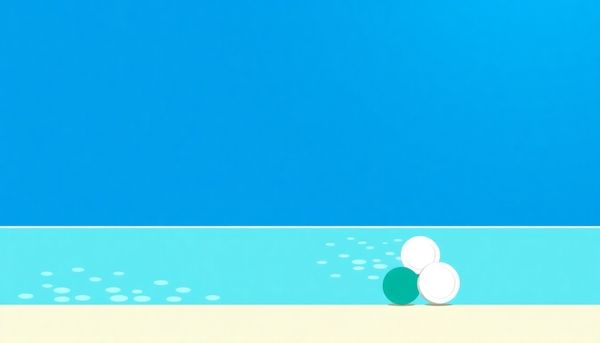
All too often, pool owners find themselves battling the invisible but crucial factor: low cyanuric acid (CYA) levels. This can transform your sparkling oasis into a breeding ground for algae and bacteria. To combat this, understanding the root causes and remedies is essential.
Firstly, using unstabilized chlorine might be the culprit. Chlorine types like sodium hypochlorite lack CYA, making them vulnerable to the sun's rays. Switching to stabilized chlorine, such as trichlor or dichlor, can be a game-changer. These products come with built-in CYA, offering dual benefits of sanitation and UV protection. It's like arming your chlorine army with shields against the sun.
However, even stabilized chlorine needs a check on its CYA levels. Consider adding pure CYA, available as pool stabilizer or conditioner, directly to your pool water. A straightforward method involves dissolving this stabilizer in a bucket of pool water and adding the mixture into the pool skimmer. Running the pool pump afterward will ensure proper distribution. This process requires patience, as it takes time to observe changes in CYA levels.
Keep in mind, replenishing CYA isn’t a frequent task. Regular testing is key to maintaining the ideal balance of 30 to 50 ppm, or slightly higher for saltwater pools. By addressing low CYA levels promptly, you not only protect your chlorine but also ensure a safe and clean swimming environment.
Balancing water chemistry is akin to tuning an orchestra; each component must harmonize to maintain a pristine aquatic environment. For those overseeing outdoor pools, low cyanuric acid levels can wreak havoc, leaving your chlorine defenseless against sunlight. Before jumping into corrective measures, a comprehensive test is paramount. This ensures you understand your pool's current chemistry, identifying which elements need adjusting.
Friends often ask why their pool water seems to drink chlorine faster than they can add it. The culprit is often the lack of a stabilizing shield like CYA. Begin by using a liquid test kit or reliable test strips to gauge your pool's cyanuric acid, pH, and alkalinity levels. Once you have the results, adjust the pH and total alkalinity first. Balanced levels here create a stable foundation, enhancing the effectiveness of any CYA you introduce.
When it comes to adding cyanuric acid, proceed with caution. Many a pool owner has learned the hard way that overshooting the mark can lead to more complex issues. Begin with small increments; it's easier to add than to take away. After the addition, run the pool pump to ensure even distribution and retest the water, adjusting as necessary. This methodical approach not only protects your pool but also ensures a summer of carefree swimming.
In the world of pool maintenance, adding stabilized chlorine can be a game-changer for keeping your water pristine. A few summers back, I struggled with maintaining the right CYA levels in my backyard pool. Every time the sun peeked out, it felt like my chlorine evaporated before my eyes. That's when I discovered the magic of stabilized chlorine, specifically sodium dichlor and trichlor. These products contain built-in cyanuric acid, acting like a sunscreen for your chlorine, significantly slowing down its degradation under those relentless UV rays.
Switching from unstabilized to stabilized chlorine was like night and day. My pool stayed clear longer, and I spent less time fussing over chemical imbalances. It's important to note, however, that not all chlorine is created equal. Unstabilized options like liquid bleach or calcium hypochlorite lack this protective element, leaving your pool vulnerable to rapid chlorine loss.
When selecting stabilized chlorine, consider your pool's specific needs. Tablets are convenient for ongoing maintenance, while granules can be more versatile for quick adjustments. Remember, though, the golden rule: moderation. Adding too much CYA can lead to its own set of problems, so start slow and test frequently. Incorporating stabilized chlorine into your routine not only shields your pool from the sun’s harshness but also gives you more time to enjoy those refreshing dips without worry.
The relentless sun can quickly become the arch-nemesis of your pool’s chlorine. Without proper shielding, sunlight depletes chlorine faster than you can say "cannonball." Cyanuric acid (CYA), often referred to as pool stabilizer, acts as an invisible umbrella that protects your chlorine from the sun's UV rays. When CYA levels dip below the recommended 30 to 50 parts per million (PPM), the chlorine in your pool becomes vulnerable, making it difficult to maintain clean, safe water.
A backyard pool party on a sunny day is delightful, but excessive sun exposure without adequate CYA can lead to a rapid decline in chlorine levels. This not only forces you to add more chlorine frequently but can also result in unsanitary conditions as bacteria and algae find an opportunity to thrive. For saltwater pools, a slightly higher CYA concentration of 60 to 80 PPM is advisable, given that salt systems continuously produce chlorine that still needs UV protection.
To counteract this, introducing stabilized chlorine products such as dichlor or trichlor is an effective strategy. These come pre-mixed with CYA, offering an easy fix to low stabilizer levels. Alternatively, adding a dedicated pool stabilizer directly to the water can quickly bring your CYA levels back within the safe range. Just remember, gradual adjustments are key. Unlike other chemicals, CYA is easier to add than to remove. So, take it slow, monitor your levels closely, and enjoy a crystal-clear pool all season long.
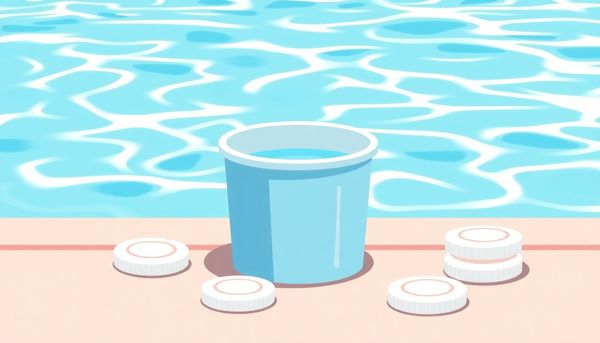
Chlorine plays the starring role in maintaining a clean pool, yet without its trusty sidekick, cyanuric acid (CYA), it’s left vulnerable and fleeting. Imagine spending an afternoon under the sun, watching your chlorine vanish faster than a snowflake in July. This is where avoiding chlorine waste becomes crucial.
Most outdoor pool owners have tasted the frustration of watching their chlorine evaporate in the sun's relentless rays. The solution? Stabilizing your chlorine with adequate CYA levels. When CYA levels drop below the recommended 30-50 parts per million (PPM), your chlorine is left exposed, diminishing quickly and forcing you to add more than necessary. This not only strains your pool maintenance routine but also weighs heavily on your pocketbook.
To keep your chlorine working efficiently, begin with stabilized chlorine forms like dichlor or trichlor. These options come preloaded with CYA, making it a straightforward swap if you’ve been relying on unstabilized alternatives like liquid bleach. If a more direct approach suits you, consider adding pure CYA to fortify your pool’s defenses. Just remember, it's wise to introduce CYA gradually, as over-application can tip the scales in the opposite direction, leading to its own challenges.
Ultimately, maintaining optimal CYA levels ensures your chlorine doesn’t go to waste, keeping your pool sparkling and safe. By respecting the balance between chlorine and CYA, you’re not just maintaining a pool – you’re ensuring a summer filled with carefree swims and fewer maintenance headaches.
Understanding the relentless power of the sun, a pool owner swears by a small but mighty ally: cyanuric acid. Think of it as sunscreen for your pool's chlorine. Without this protective layer, chlorine, tasked with keeping your pool pristine, is vulnerable to the sun’s harsh UV rays, vanishing faster than a popsicle on a hot day. Not only does this constant evaporation lead to waste, but it also invites bacteria and algae to take up residence in your pool, turning your backyard oasis into an unsanitary puddle.
Checking your pool's cyanuric acid levels is a routine worth adopting, especially if you own an outdoor pool. These levels should ideally sit between 30 and 50 parts per million (PPM), and slightly higher for saltwater systems. If your readings fall short, introducing a pool stabilizer or conditioner is crucial. Stabilized chlorine, such as sodium dichlor or trichlor, not only sanitizes but also supplies the necessary CYA, killing two birds with one stone.
Years ago, I faced a similar dilemma. After a bout of heavy rain diluted my pool, my chlorine levels plummeted. By testing the water and judiciously adding a stabilized chlorine product, I restored balance to my aquatic sanctuary. The lesson? Keeping an eye on CYA levels ensures your chlorine works efficiently, warding off unwanted pool guests and ensuring crystal-clear waters for those sunny day swims.
Addressing low cyanuric acid levels in your pool demands a bit of proactive care, but the payoff is a crystal-clear oasis under the sun. The invisible guardian of your chlorine, cyanuric acid ensures that your sanitizing efforts don’t evaporate with the morning dew. So, when levels dip, swift action is key.
First, understanding the culprit behind low levels can help prevent future dips. Frequent rain, splashouts, or draining can dilute your pool's CYA. Ever noticed how a storm seems to wash away more than just the dirt from your patio? While refreshing, rainwater lacks the stabilizing properties your pool desperately needs.
To remedy this, begin with a precise water test using either strips or a liquid kit. Knowing your pool’s current state is essential before adding any chemicals. Now, consider introducing a pool stabilizer or conditioner, which is essentially pure cyanuric acid. A common method involves dissolving the stabilizer in a bucket of warm water before adding it to the pool — a little trick I picked up after witnessing the power of splashback firsthand.
Alternatively, switch to using stabilized chlorine like dichlor or trichlor, which infuses your pool with a steady supply of CYA. By opting for these products, you not only stabilize the chlorine but also save yourself from constant chemical juggling.
Remember, patience is your ally. CYA levels are much easier to increase than decrease, so take a gradual approach. By maintaining the right cyanuric acid levels, you can safeguard your pool’s chlorine, ensuring it remains a safe, inviting place to swim.
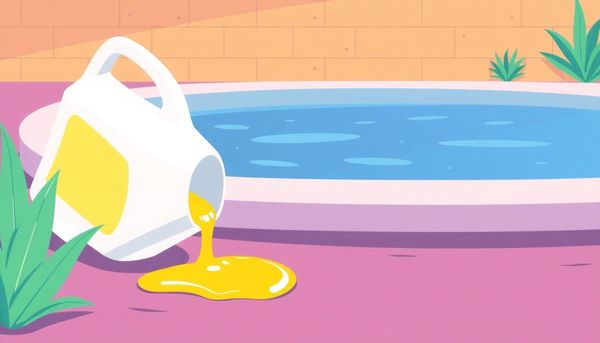
This article provided insights into maintaining your pool. Start your pool care journey today!
Want to become a pool maintenance expert? Our free Pool School course covers everything you need to know about pool care. From basic maintenance to advanced troubleshooting, you'll learn how to:
Join over 10,000 pool owners who have already transformed their pool care routine. Get started with our free Pool School course today!